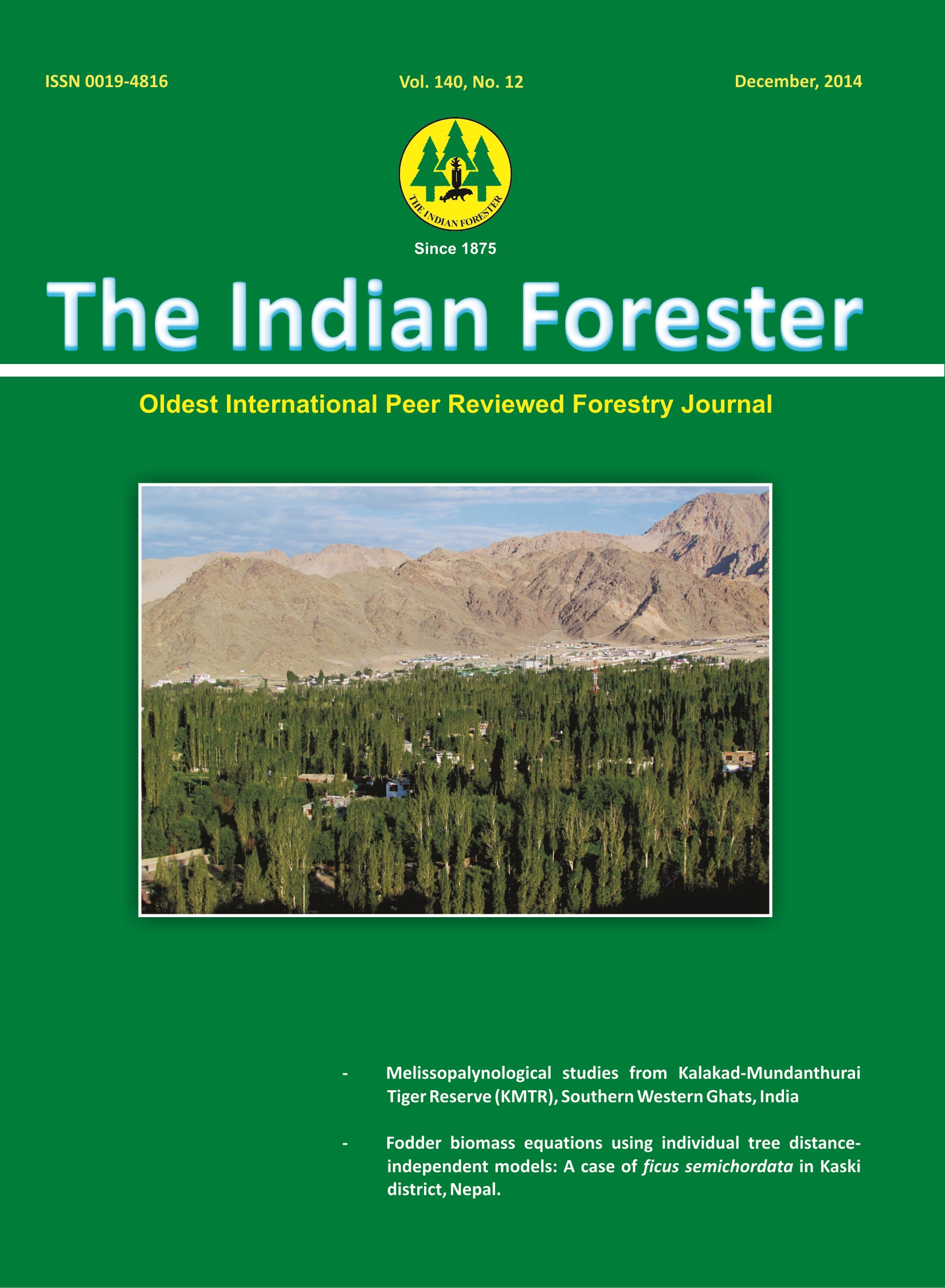Fodder Biomass Equations Using Individual Tree Distance-independent Models: a Case of Ficus semichordata in Kaski District, Nepal
DOI:
https://doi.org/10.36808/if/2014/v140i12/55248Keywords:
Fodder Biomass, Farmland, Regression, Ficus semichordata, NepalAbstract
Fodder trees, Ficus semichordata has high feeding value and is regarded as one of the most popular fodder trees for feeding livestock in mid-hills of Nepal. If the amount of fodder biomass yield could be estimated, systematic feeding system could be developed accordingly. Linear regression equations were developed for fodder biomass of F. semichordata tree, expressed as a function of easily measured parameters such as diameter at breast height, crown diameter and tree height. Individual tree distance-independent models were used as most fodder tree species are managed on an individual tree basis. Data were collected from experimental plots established in the farmers' farmland in Kaski district of Nepal. Aspect specific equations were developed at first as the plots were established on four different aspects. The single variable SD<SUB>1.37m</SUB> i.e. stemdiameter at 1.37m height from base best predicted the TFFW i.e. 1.37m 2 2 total fresh fodder biomass (R<SUP>2</SUP> > 0.90, S.E. < 3.30) and EODFW i.e. oven dry fodder biomass (R<SUP>2</SUP> > 0.87, S.E. < 1.42) in all the four aspects. Inclusion of additional variables increased multicollinearity beyond the acceptable range. Inclusion of 2 crown diameter data in the model brought about slight improvement in the performance of the model (R<SUP>2</SUP> > 0.97, S.E. < 2 2 for fresh fodder and R<SUP>2</SUP> > 0.93, S.E. < 1 for oven dry fodder) but the condition index was more than 18 and 20. The data 2 from all the aspects were pooled to develop the single regional model: TFFW = -12.279 + 2.672* SD<SUB>1.37m</SUB> (R<SUP>2</SUP> > 0.91, S.E. < 1.37m 2 3.30), the corresponding model for estimated oven dry fodder weight is EODFW = -3.789 + 0.853* SD<SUB>1.37m</SUB> (R<SUP>2</SUP> > 0.88, S.E. < 1.37m 1.22).References
Amatya S.M. (1988). Variations of Khanyu (Ficus semicordata) in Nepal. In: Proceedings of the 2nd meeting of the working group on fodder trees, forest fodder and leaf litter ( P J Robinson Edt). pp 14-16. FRIC Occasional Paper 2/88. Kathmandu.
Anon. (1990). Official Methods of Analysis. 13th Ed. Association of Official Analytical Chemists (AOAC), Washington, DC.
Applegate G.B., Hawinks T. and Thompson I.S. (1985). Preliminary guidelines for biomass studies in Nepal. Technical Note 2/85. Nepal Australia Forestry Project, Kathmandu, Nepal.
Baker T.G., ATT will R.M. and Stewart H.T.C. (1984). Biomass equations for Pinus radiata in Gippsland, Victoria New Zealand. Journal of Forest Science, 14: 89-96.
CBS (2001). Statistical Year Book of Nepal, Central Bureau of Statistics, National Planning Commission, Government of Nepal, Kathmandu. DDC-Kaski (2004).“District Development Committee, Kaski, Nepalâ€. http://www.ddckaski.org
Fuwape J.A., Onyekwelu J.C. and Andekunle V.A.J. (2001). Biomass equations and estimation for Gmelina arborea and Nauclea diderrichii stands in Akure forest reserve. Biomass and Bioenergy, 21: 401-405.
Harrison A. (1989). A yield table for Firewood Production from Utis (Alnus nepalensis). Lumle Agricultural center, Tech, paper 14, LAC, Pokhara, Nepal.
Hawkins T. (1987). Volume and weight tables for Eucalyptus camaldnlensis, Dalbergia sissoo, Acacia auriculoformis and Casia simea. Banko Jankari, 1(2): 29-30.
Heuch, J.H.R. (1986). Fodder for foresters-an introduction to tree fodder use in Nepal. Lumle Agricultural Center, Technical Paper 13/86. Lumle Agricultural Centre, Kaski, Nepal.
Joshi M.R. (1985). Prediction of biomass in a Plantation Stand of Chir Pine (Pinus roxburghii) in Nepal. M.Sc. Thesis, University of Oxford, UK.
Karki M.B. (1992). Improved Fodder management in the Agro forestry System of central and western Nepal. PhD thesis, Michigan State University, USA.
Kozak A. (1970). Methods of ensuring additivity of biomass components by regression analysis. Forestry Chronicle, 46 (5): 402-404.
Mohns B., Applegate G.B. and Gilmour D.A. (1988). Biomass and productivity estimations for community forest management: A case study from the hills of Nepal-II. Dry Matter Production in Mixed Young Stands of Chir Pine (Pinus roxburghii) and Broad-leaved Species. Biomass, 17: 165-184.
Myers, R.H. (1990). Classical and Modern Regression with Applications. PWS-KENT Publishing Company, Boston, MA. 1-488.
Rana S.R. and Amatya N. (2000). Fodder trees as a potential resource of livestock feed in the western hills of Nepal. In: proceedings of the national level workshop on Improved Strategies for Identifying and Addressing Fodder Deficits in the Mid-Hills of Nepal, 5th -6th September, 2000.
Satto T. and Madgwick H. (1982). Forest Biomass. Martinus Nijhoff/Dr. W. Junk. The Hague, Netherlands.
Sherchand L. and Pariyar D. (2002). Pasture, Forage and Agroforestry Technologies and Their Dissemination Status in Nepal. Recent Spread th and Impact of Agricultural Technologies in Nepal. Proceedings of the 6 National Outreach Workshop held at NARC, Kathmandu Nepal.
Shrestha H.R. and Pradhan D.R. (1995) Research priorities for animal agriculture by agro-ecological zone in Nepal. In: Global Agenda for Livestock Research (Edited: C. Devendra and P. Gardiner). Proceedings of the consultation for the South Asia Region, ICRISAT Asia Centre, Patancheru, India, 6-8-June, 1995. ILRI, Nairobi, Kenya. 85-101.
St. Clair J.B. (1993). Family differences in equations for predicting biomass and leaf area in Douglas Fir (Pseudotsuga menziesii var.menziesii). Forest Science, 39: 743-755.
Stewart J. (1990). International trialofCentralAmericandry zonehardwoodspecies-evaluationmanual,Oxford Forestry Institute,Oxford,UK.
Sultan, J.I., Rahim, I., Nawaz, H., Yaqoob, M. and Javed, I. (2008). Nutritional evaluation of fodder tree leaves of northern grasslands of Pakistan. Pak. J. Bot., 40(6): 2503-2512.
Upton P. L. J. and Robinson, P. J. (1988). Fodder Tree Survey of South Lalitpur. In: Proceedings of the 2nd meeting of the working group on fodder trees, forest fodder and leaf litter (P J Robinson Edt). pp 34-36. FRIC Occasional Paper 2/88. Kathmandu. Wilkinson, L. (1990). SYSTAT Statistic Package 1990(version 5). SYSTAT Inc., Evanston, Illinois, U.S.A
Downloads
Downloads
Published
How to Cite
Issue
Section
License
Unless otherwise stated, copyright or similar rights in all materials presented on the site, including graphical images, are owned by Indian Forester.





